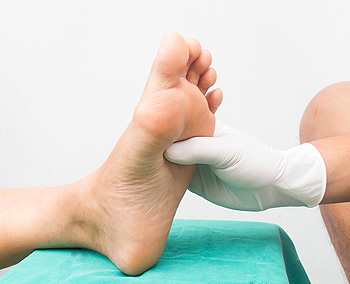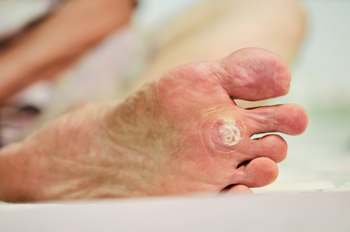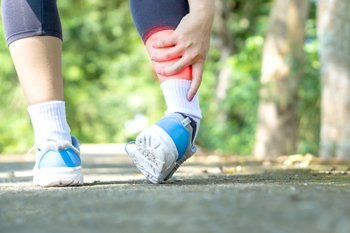October 2020
Should I Get Orthotics?
 Orthotics are devices made of molded rubber, leather, metal, plastic, or other synthetic material that are placed into the shoes in order to balance the foot in a neutral position and cushion it. A podiatrist may recommend or prescribe a custom orthotic if you have specific foot problems, such as an unusually shaped foot or over pronated feet when walking. They may also be prescribed to help with foot pain caused by medical conditions such as diabetes, plantar fasciitis, and arthritis. If you don’t necessarily want to invest in an expensive custom-made orthotic, drugstores, supermarkets, and sporting goods stores all sell generic orthotics which may help relieve general foot pain. For more information about orthotics, speak with a podiatrist today.
Orthotics are devices made of molded rubber, leather, metal, plastic, or other synthetic material that are placed into the shoes in order to balance the foot in a neutral position and cushion it. A podiatrist may recommend or prescribe a custom orthotic if you have specific foot problems, such as an unusually shaped foot or over pronated feet when walking. They may also be prescribed to help with foot pain caused by medical conditions such as diabetes, plantar fasciitis, and arthritis. If you don’t necessarily want to invest in an expensive custom-made orthotic, drugstores, supermarkets, and sporting goods stores all sell generic orthotics which may help relieve general foot pain. For more information about orthotics, speak with a podiatrist today.
If you are having discomfort in your feet and would like to try orthotics, contact Dr. Robert Graser from Graser Podiatry and Bunion Surgery Institute. Our doctor can provide the care you need to keep you pain-free and on your feet.
What Are Orthotics?
Orthotics are inserts you can place into your shoes to help with a variety of foot problems such as flat feet or foot pain. Orthotics provide relief and comfort for minor foot and heel pain but can’t correct serious biomechanical problems in your feet.
Over-the-Counter Inserts
Orthotics come in a wide variety of over-the-counter inserts that are used to treat foot pain, heel pain, and minor problems. For example, arch supports can be inserted into your shoes to help correct overarched or flat feet, while gel insoles are often used because they provide comfort and relief from foot and heel pain by alleviating pressure.
Prescription Orthotics
If over-the-counter inserts don’t work for you or if you have a more severe foot concern, it is possible to have your podiatrist prescribe custom orthotics. These high-quality inserts are designed to treat problems such as abnormal motion, plantar fasciitis, and severe forms of heel pain. They can even be used to help patients suffering from diabetes by treating foot ulcers and painful calluses and are usually molded to your feet individually, which allows them to provide full support and comfort.
If you are experiencing minor to severe foot or heel pain, it’s recommended to speak with your podiatrist about the possibilities of using orthotics. A podiatrist can determine which type of orthotic is right for you and allow you to take the first steps towards being pain-free.
If you have any questions please contact our office located in Boerne, . We offer the newest diagnostic and treatment technologies for all your foot and ankle needs.
What Are the Symptoms of Diabetic Peripheral Neuropathy?
 Diabetic peripheral neuropathy is a condition associated with diabetes that causes nerve damage in the legs, feet, and toes. Nearly 60% of all diabetics have some sort of nerve damage. Because of how prevalent and potentially dangerous diabetic peripheral neuropathy can be, it is important to recognize the signs and symptoms of this condition. The symptoms of diabetic peripheral neuropathy that affect the lower limbs may include numbness, tingling, and pain in the legs, feet, or toes. You may also experience other symptoms throughout the body, such as indigestion, nausea, vomiting, diarrhea or constipation, dizziness or fainting, and problems with urination. The risk of nerve damage due to diabetes increases in people who have difficulty managing their blood sugar levels, have high blood pressure, are overweight, and are over 40 years old. If you have the symptoms of diabetic peripheral neuropathy, it is suggested that you are under the care of a podiatrist, who can help you take care of your lower limbs and manage this condition.
Diabetic peripheral neuropathy is a condition associated with diabetes that causes nerve damage in the legs, feet, and toes. Nearly 60% of all diabetics have some sort of nerve damage. Because of how prevalent and potentially dangerous diabetic peripheral neuropathy can be, it is important to recognize the signs and symptoms of this condition. The symptoms of diabetic peripheral neuropathy that affect the lower limbs may include numbness, tingling, and pain in the legs, feet, or toes. You may also experience other symptoms throughout the body, such as indigestion, nausea, vomiting, diarrhea or constipation, dizziness or fainting, and problems with urination. The risk of nerve damage due to diabetes increases in people who have difficulty managing their blood sugar levels, have high blood pressure, are overweight, and are over 40 years old. If you have the symptoms of diabetic peripheral neuropathy, it is suggested that you are under the care of a podiatrist, who can help you take care of your lower limbs and manage this condition.
Neuropathy
Neuropathy can be a potentially serious condition, especially if it is left undiagnosed. If you have any concerns that you may be experiencing nerve loss in your feet, consult with Dr. Robert Graser from Graser Podiatry and Bunion Surgery Institute. Our doctor will assess your condition and provide you with quality foot and ankle treatment for neuropathy.
What Is Neuropathy?
Neuropathy is a condition that leads to damage to the nerves in the body. Peripheral neuropathy, or neuropathy that affects your peripheral nervous system, usually occurs in the feet. Neuropathy can be triggered by a number of different causes. Such causes include diabetes, infections, cancers, disorders, and toxic substances.
Symptoms of Neuropathy Include:
- Numbness
- Sensation loss
- Prickling and tingling sensations
- Throbbing, freezing, burning pains
- Muscle weakness
Those with diabetes are at serious risk due to being unable to feel an ulcer on their feet. Diabetics usually also suffer from poor blood circulation. This can lead to the wound not healing, infections occurring, and the limb may have to be amputated.
Treatment
To treat neuropathy in the foot, podiatrists will first diagnose the cause of the neuropathy. Figuring out the underlying cause of the neuropathy will allow the podiatrist to prescribe the best treatment, whether it be caused by diabetes, toxic substance exposure, infection, etc. If the nerve has not died, then it’s possible that sensation may be able to return to the foot.
Pain medication may be issued for pain. Electrical nerve stimulation can be used to stimulate nerves. If the neuropathy is caused from pressure on the nerves, then surgery may be necessary.
If you have any questions, please feel free to contact our office located in Boerne, . We offer the newest diagnostic and treatment technologies for all your foot care needs.
Where Are Plantar Warts Located?
 Plantar warts are those that are found on the bottom of the feet. Warts are caused by a virus that is known as the human papillomavirus (HPV). This virus can enter the body through a tiny break in the skin, and generally affects the top layer of skin. Plantar warts grow inward on the soles of the feet. This is a result of standing and walking for the majority of the day. A plantar wart appears as a small patch of hardened skin, and often has small, black dots in the center. These types of warts can cause severe pain and discomfort, and it is beneficial to quickly begin treatment. This can consist of applying salicylic acid to the wart, or possibly freezing it. If you have a plantar’s wart, it is suggested that you consult with a podiatrist who can determine what the best form of treatment is for you.
Plantar warts are those that are found on the bottom of the feet. Warts are caused by a virus that is known as the human papillomavirus (HPV). This virus can enter the body through a tiny break in the skin, and generally affects the top layer of skin. Plantar warts grow inward on the soles of the feet. This is a result of standing and walking for the majority of the day. A plantar wart appears as a small patch of hardened skin, and often has small, black dots in the center. These types of warts can cause severe pain and discomfort, and it is beneficial to quickly begin treatment. This can consist of applying salicylic acid to the wart, or possibly freezing it. If you have a plantar’s wart, it is suggested that you consult with a podiatrist who can determine what the best form of treatment is for you.
Plantar warts can be very uncomfortable. If you need your feet checked, contact Dr. Robert Graser from Graser Podiatry and Bunion Surgery Institute. Our doctor will assist you with all of your foot and ankle needs.
About Plantar Warts
Plantar warts are the result of HPV, or human papillomavirus, getting into open wounds on the feet. They are mostly found on the heels or balls of the feet.
While plantar warts are generally harmless, those experiencing excessive pain or those suffering from diabetes or a compromised immune system require immediate medical care. Plantar warts are easily diagnosed, usually through scraping off a bit of rough skin or by getting a biopsy.
Symptoms
- Lesions on the bottom of your feet, usually rough and grainy
- Hard or thick callused spots
- Wart seeds, which are small clotted blood vessels that look like little black spots
- Pain, discomfort, or tenderness of your feet when walking or standing
Treatment
- Freezing
- Electric tool removal
- Laser Treatment
- Topical Creams (prescription only)
- Over-the-counter medications
To help prevent developing plantar warts, avoid walking barefoot over abrasive surfaces that can cause cuts or wounds for HPV to get into. Avoiding direct contact with other warts, as well as not picking or rubbing existing warts, can help prevent the further spread of plantar warts. However, if you think you have developed plantar warts, speak to your podiatrist. He or she can diagnose the warts on your feet and recommend the appropriate treatment options.
If you have any questions please feel free to contact our office located in Boerne, . We offer the newest diagnostic and treatment technologies for all your foot and ankle needs.
Helpful Techniques for Running Safely
 Running is an excellent form of physical activity, however it can also cause injury if improper training is practiced. There are a few useful techniques you can follow to help prevent running injuries. Regularly switching between the different types of surfaces you run on can be beneficial in keeping your leg muscles strong and avoiding straining your muscles. Wearing shoes that are specific to the type of running you enjoy can also help to prevent injury. Another technique that should be followed is tracking your mileage. By tracking your mileage, you’ll be able to get a good idea of when your shoes should be switched out to avoid running in worn out footwear. For more advice on how to avoid running injuries, please speak with a podiatrist.
Running is an excellent form of physical activity, however it can also cause injury if improper training is practiced. There are a few useful techniques you can follow to help prevent running injuries. Regularly switching between the different types of surfaces you run on can be beneficial in keeping your leg muscles strong and avoiding straining your muscles. Wearing shoes that are specific to the type of running you enjoy can also help to prevent injury. Another technique that should be followed is tracking your mileage. By tracking your mileage, you’ll be able to get a good idea of when your shoes should be switched out to avoid running in worn out footwear. For more advice on how to avoid running injuries, please speak with a podiatrist.
Exercising your feet regularly with the proper foot wear is a great way to prevent injuries. If you have any concerns about your feet, contact Dr. Robert Graser of Graser Podiatry and Bunion Surgery Institute. Our doctor will treat your foot and ankle needs.
How to Prevent Running Injuries
Many common running injuries are caused by overuse and overtraining. When the back of the kneecap starts wearing out and starts causing pain in your knee, this is commonly referred to as runner’s knee. Runner’s knee is a decrease in strength in your quadriceps and can occur if you’re not wearing properly fitted or supporting shoes. To prevent runner’s knee, focusing on hip strengthening is a good idea, as well as strengthening your quads to keep the kneecaps aligned.
What Are Some Causes of Running Injuries?
- One cause of a common running injury is called iliotibial band syndrome.
- Plantar fasciitis is also another common injury.
- Stress fractures can occur from overtraining, lack of calcium, or even your running style.
Best Ways to Prevent Running Injuries
- Wear footwear that fits properly and suits your running needs.
- Running shoes are the only protective gear that runners have to safeguard them from injury.
- Make a training schedule. Adding strengthening exercises as well as regular stretching can help keep you strong and limber and can lessen the possibility of injuries.
- Stretching keeps muscles limber; this will help you gain better flexibility.
If you have any questions please feel free to contact our office located in Boerne, . We offer the newest diagnostic and treatment technologies for all your foot and ankle needs.
Blog Archives
- July 2024
- June 2024
- May 2024
- April 2024
- March 2024
- February 2024
- January 2024
- December 2023
- November 2023
- October 2023
- September 2023
- August 2023
- July 2023
- June 2023
- May 2023
- April 2023
- March 2023
- February 2023
- January 2023
- December 2022
- November 2022
- October 2022
- September 2022
- August 2022
- July 2022
- June 2022
- May 2022
- April 2022
- March 2022
- February 2022
- January 2022
- December 2021
- November 2021
- October 2021
- September 2021
- August 2021
- July 2021
- June 2021
- May 2021
- April 2021
- March 2021
- February 2021
- January 2021
- December 2020
- November 2020
- October 2020
- September 2020
- August 2020
- July 2020
- June 2020
- May 2020
- April 2020
- March 2020
- February 2020
- January 2020
- December 2019
- November 2019
- October 2019
- September 2019
- August 2019
- July 2019
- June 2019
- May 2019
- April 2019
- March 2019
- February 2019
- January 2019
- December 2018
- November 2018
- October 2018
- September 2018
- August 2018
- July 2018
- June 2018
- May 2018









